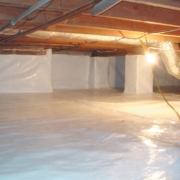5 Steps in Crawl Space Encapsulation in Atlanta GA
Crawl Space Encapsulation in Atlanta GA
A crawl space might not be the most important space in your house but what happens in there greatly affects the rest of the property. One major issue that homeowners have to contend with regarding these spaces is flooding.
This is a problem that is out of sight and only comes to light when a lot of damage has already been done. However, the problem can be resolved through crawl space encapsulation by a qualified contractor.
The Danger of a Leaking Crawl Space
If your property features a crawl space, it is important to have a contractor regularly inspect the space for water leakage. In addition, they should also check the humidity levels. A wet crawl space attracts pest infestation into your property. Worse still, growth of mold is promoted by high moisture levels in the crawl space and this poses a health risk to the occupants.
Uncontrolled moisture in the crawl space also leads to rot and rust, which affects the integrity of the foundation. A weak foundation poses a great risk to the property especially in case of floods. If there are high moisture levels in this space, you will notice an increase in the energy bill as the AC system is forced to work harder.
How to Install Crawl Space Encapsulation
It is important to appreciate the role of a certified contractor in crawl space waterproofing. These experts have prerequisite expertise and equipment to get the job done more effectively. More importantly, they know the latest waterproofing trends in the industry that are more effective and affordable.
Here are the steps involved in the project:
- Assessment of the crawl space conditions: A crawl space is not easy to access and this is another reason you need to hire a professional to get the job done. This phase will involve inspection of water damage and identification of the source of the leak.
- Removal of water: This entails installation of a sump pump on the floor. All collected water is pumped away from this space.
- Sealing the gaps and vents: Any space that can allow moisture or water vapor should be sealed to make the space air tight. Piping and heating systems should also be repaired if there are any signs of leaks. The vent covers must also be sealed tightly to avoid any moisture entry.
- Crawl space encapsulation: This entails covering every space including walls and floor to avoid any moisture entry. A thick polyethylene sheet is used for this purpose to create a completely dry space.
- Dehumidification: A crawl space dehumidifier is essential to maintain low humidity levels. This will also reduce energy consumption in the upper levels of the house.
Go ahead and call in a waterproofing contractor for inspection and improve the indoor air quality in your home.



